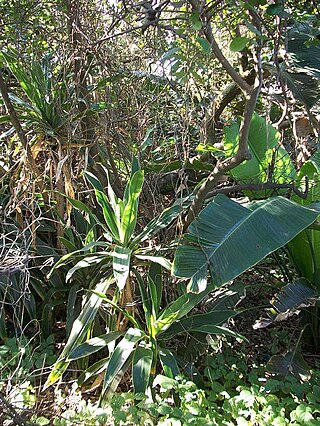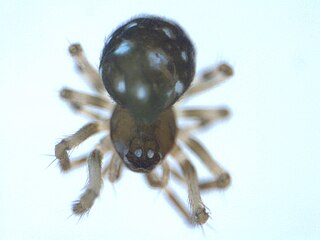
The corn snake, sometimes called red rat snake, is a species of North American rat snake in the family Colubridae. The species subdues its small prey by constriction. It is found throughout the southeastern and central United States. Though superficially resembling the venomous copperhead and often killed as a result of this mistaken identity, the corn snake lacks functional venom and is harmless. The corn snake is beneficial to humans because it helps to control populations of wild rodent pests that damage crops and spread disease.

The Mygalomorphae, or mygalomorphs, are an infraorder of spiders, and comprise one of three major groups of living spiders with over 3,000 species, found on all continents except Antarctica. Many members are known as trapdoor spiders due to their creation of trapdoors over their burrows. Other prominent groups include Australian funnel web spiders and tarantulas, with the latter accounting for around one third of all mygalomorphs.

The Pholcidae are a family of araneomorph spiders. The family contains more than 1,800 individual species of pholcids, including those commonly known as cellar spider, daddy long-legs spider, carpenter spider, daddy long-legger, vibrating spider, gyrating spider, long daddy, and skull spider. The family, first described by Carl Ludwig Koch in 1850, is divided into 94 genera.

The Goliath birdeater belongs to the tarantula family Theraphosidae. Found in northern South America, it is the largest spider in the world by mass and body length, and second to the giant huntsman spider by leg span. It is also called the Goliath tarantula or Goliath bird-eating spider; the practice of calling theraphosids "bird-eating" derives from an early 18th-century copper engraving by Maria Sibylla Merian that shows one eating a hummingbird. Despite the spider's name, it rarely preys on birds.

The spotted turtle, the only species of the genus Clemmys, is a small, semi-aquatic turtle that reaches a carapace length of 8–12 cm (3.1–4.7 in) upon adulthood. Their broad, smooth, low dark-colored upper shell, or carapace, ranges in its exact colour from black to a bluish black with a number of tiny yellow round spots. The spotting patterning extends from the head, to the neck and out onto the limbs. Sexually mature males have a concave plastron and a long, thick tail. By contrast, sexually mature females possess a flat plastron and have a tail that is noticeably shorter and thinner than that of mature males. Mature males also have a dark iris and face; females typically have a yellow or orange iris and a similarly coloured face that is distinctly lighter than the males'. Juveniles appear female-like in this regard, and at maturity males begin to develop darker features.

Mysmenidae is a spider family with about 180 described species in seventeen genera. The family is one of the least well known of the orb-weaving spiders because of their small size and cryptic behaviour. These spiders are found in humid habitats such as among leaf litter and in caves.

The western bowerbird is a species of bird in the family Ptilonorhynchidae. The species is a common endemic of Australia. It has a disjunct distribution, occurring in Central Australia and the Pilbara region of Western Australia.

KwaZulu-Natal Dune Forest is a subtropical forest type that was once found almost continuously along the coastal dunes of KwaZulu-Natal, South Africa. This vegetation type develops in sheltered areas behind the littoral zone, where with some protection from the salt wind it may develop with canopies as tall as 30 m. It still exists in protected areas, but much has been degraded by human activity. Coastal dune forest covers approximately 1% of the land area of KwaZulu-Natal, and is a habitat type seriously threatened from human population pressure and development, particularly titanium mining.

Crustulina guttata is a spider species with Palearctic distribution. It is notably found in Lithuania.
Afroneta is a genus of dwarf spiders that was first described by Å. Holm in 1968.
Brasilionata is a genus of Brazilian spiders first described by Wunderlich in 1995. It is represented by a single species, B. arborense. The defining characteristics of this genus include a homogeneous color pattern on the back of the abdomen, setae on the cymbial fold the same size as other setae, a space between the anterior median eyes, and a pointed switch on the end of the palpal bulb similar to that of Microdipoena. Only two specimens have been identified, one in 1995 and another in 2015.
Microdipoena saltuensis, is a species of spider of the genus Microdipoena. It is endemic to Sri Lanka.

Microdipoena is a cosmopolitan genus of dwarf cobweb weaver spiders in the family Mysmenidae. It was first described by Nathan Banks in 1895.
Drassodella is a genus of African araneomorph spiders in the family Gallieniellidae, and was first described by John Hewitt in 1916. Originally placed with the ground spiders, it was moved to the Gallieniellidae in 1990.
Pycnaxis guttata is a species of crab spider in the family Thomisidae. It is widely found in Philippines.
Tetragnatha guatemalensis, the Guatemalan long-jawed spider, is a species of long-jawed orb weaver in the family Tetragnathidae. It is found in North, Central America, Cuba, and Jamaica. Under certain conditions, such as mass emergence of midges, the spiders will weave communal webs.
Sphodros paisano is a species of purseweb spider in the family Atypidae. It is found in the United States and Mexico.

Tetragnatha viridis is a species of long-jawed orb weaver in the family of spiders known as Tetragnathidae. It is found in the United States.

The zebra finches are two species of estrildid finch in the genus Taeniopygia found in Australia and Indonesia. They are seed-eaters that travel in large flocks.

The Sunda zebra finch is a species of bird in the family Estrildidae. It is found in the Lesser Sundas.













